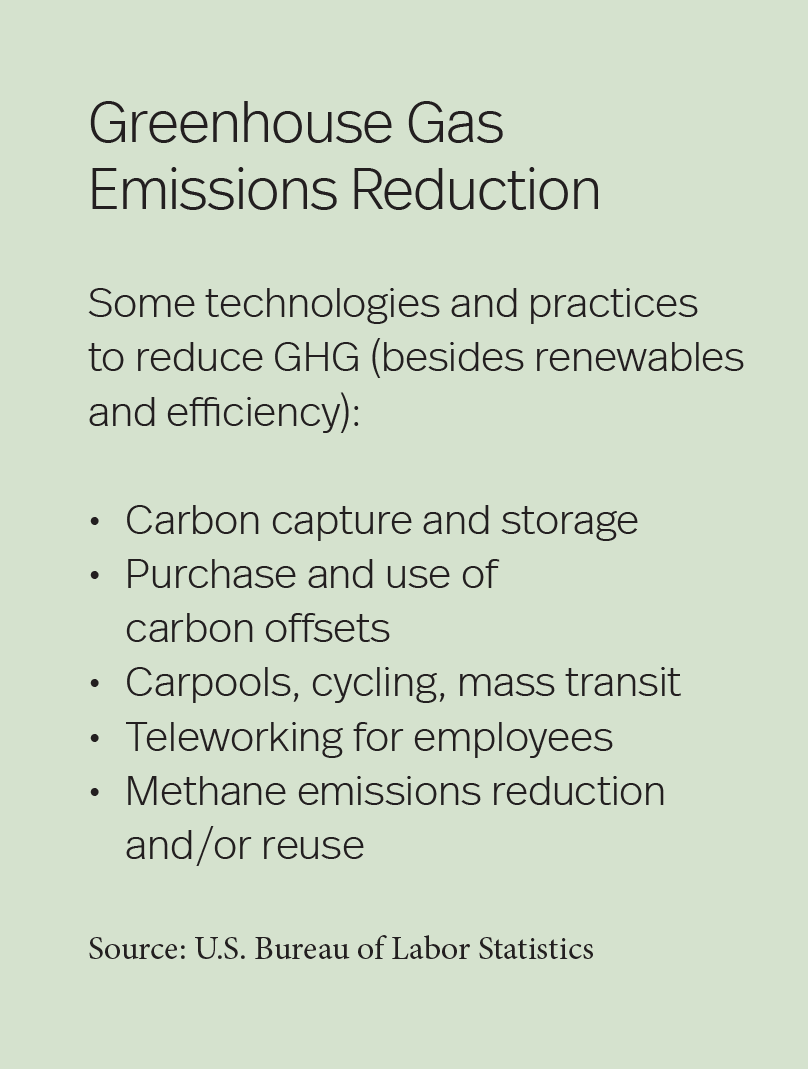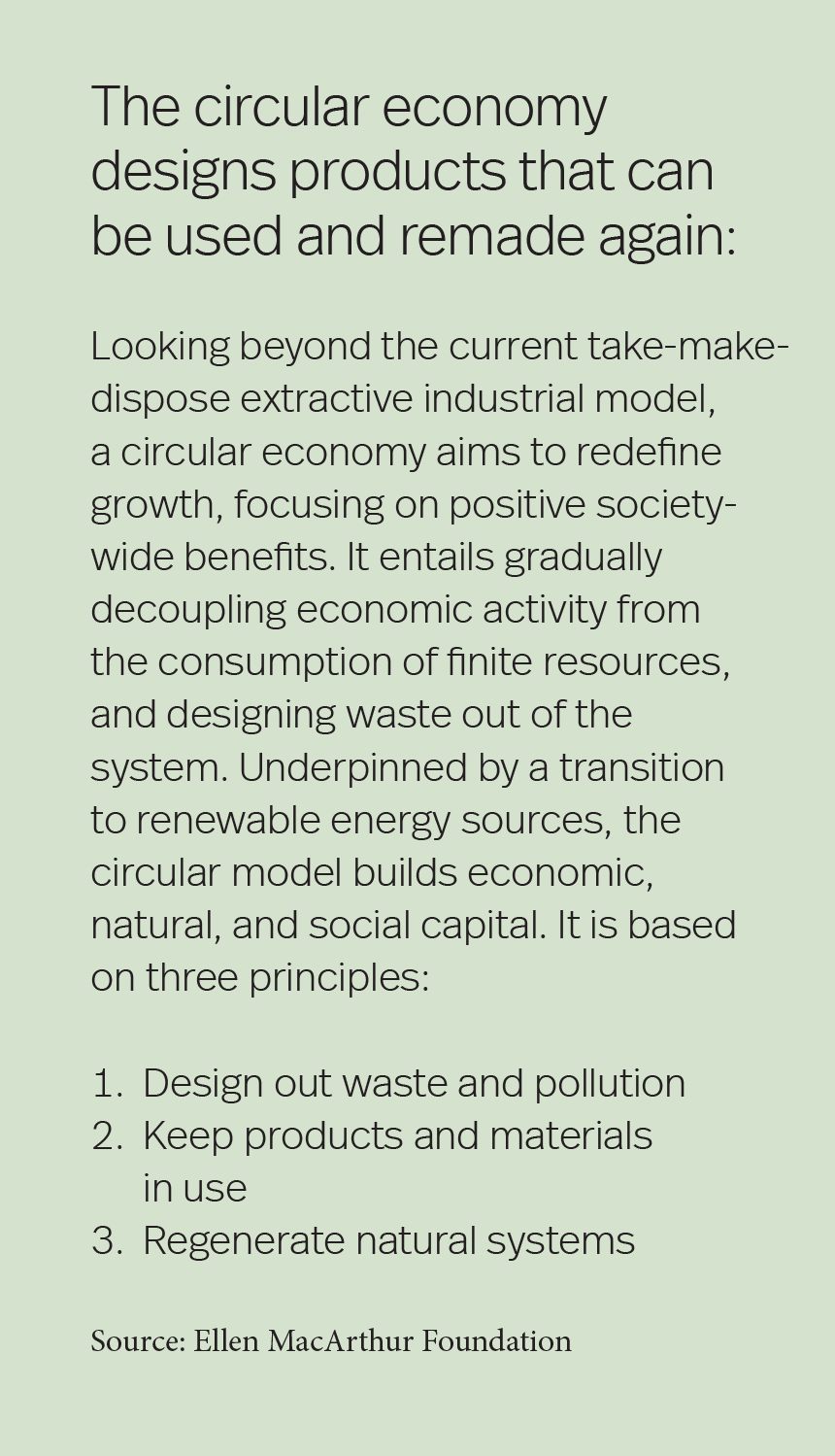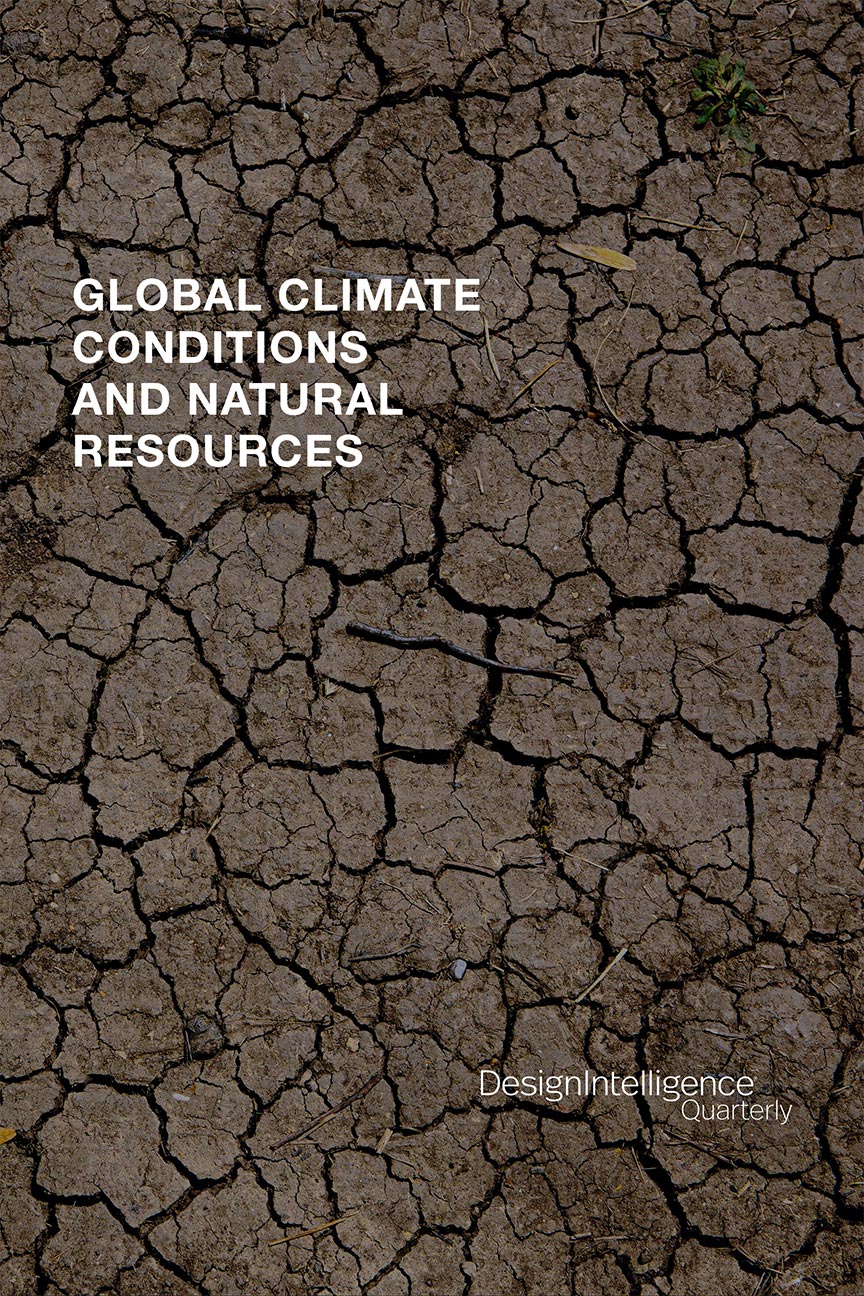Global Climate Conditions and Natural Resources
by DesignIntelligence
July 14, 2021
DesignIntelligence perspectives on sustainable design have significantly contributed to the positive shifts we’ve seen across the North American built environment. Yet all our prior efforts are nowhere near enough. The damage done to the environment, natural resources, and communities we live in has far exceeded our collective progress in the past twenty years.
The choices before us, common to many organizations, are clear:
- Just give up and accept the defeat, acknowledging that it’s just too difficult a challenge to overcome or,
- Acknowledge the challenge yet don’t waste time and resources beyond the norm; after all, it’s not wholly our problem and we can only do what we can do or,
- Stay in it, fight the good fight, lean into the challenge, and dare to make a difference far beyond our borders, our space, our stretch. Take the risk of being labeled, being deemed foolish, being different. Operate from a base of conviction, expand our relationships, and apply our best intelligence.
We believe the heart of the matter resides in human thinking, speaking, and behavior. As a society, we’ve become so used to—and complacent about — our environment that we respond to environmental happenings with a shrug and a turn, rationalizing that it will all work out somehow. Our shortsightedness comes with incalculable costs to the planet, its inhabitants, and the generations that follow.
There’s no doubt that the Earth’s climate has changed over history and that our climate is warming. NASA says that over countless millennia there have been glacial advances/retreats more than seven times. And it’s interesting to note, also according to NASA, that some of these changes in Earth’s climate—which have happened over hundreds of thousands of years of history—can be attributed to small changes in the planet’s orbit. These small changes in Earth’s orbit are what affects the amount of energy the planet receives from the sun.

Planet in Peril—Climate Change and Natural Resources
In 2013, the International Panel on Climate Change (IPCC) concluded that it’s “extremely likely that human influence has been the dominant cause of the observed warming over the 20th century.” The emission of greenhouse gases such as carbon dioxide and methane are the main causes of humanity’s impact on climate change. The climate models project that the temperature will increase anywhere from 0.5°F to 8.6 °F, depending on the levels of emissions (low to high). According to the models, then, not only will the temperatures increase, but the glaciers and sea ice will melt and retreat, and oceans will rise. There will be more extreme weather events like hurricanes and droughts and cyclones as well.
Earth’s natural resources are feeling the pinch, as well. At its fundamental level, every product we make depends on and is composed of natural resources. We depend on air, water, minerals, forests, lakes and oceans, the animal kingdom, soil and sunlight, and so much more to physically support us as human beings. Along with climate change, overconsumption and growth may impact the availability of our planet’s natural resources. Not only do our natural resources provide for our sustainability as humans, but also provide for economic growth.
Some resources—like geothermal energy, air, solar radiation—are found everywhere, all over the globe. But most resources are only located in certain areas or regions, so there can be periods of increasing scarcity and even shortages. Resource-related disruptions, therefore, will have political, environmental, and social implications, as well as economic ones. The consequences of disruptions will likely vary in scope and scale (i.e., for poorer people and nations).

Since supply chains tend to be global in today’s world, we can no longer think that resource depletion or lack of availability is a regional or even local concern. Gone, too, is the hope that a lack of resource availability may be temporary. Instead, understanding that the global economy is also tied to natural resources; in other words, reliable supply and access to natural resources is critical to the supply chains that operate the global economic engine. Any disruption in supply or availability of a resource can cause damage to output. As we know, scarcity in supply of a “good” can cause panic (case in point: the oil/gas shortage of the 1970s; there are other examples too). Low-income families around the world bear the majority of the brunt of such disruptions. Economic decline, social unrest, political instability and mass people movements result.
The world’s population is projected to grow by about 2.5 billion people over the next 30 years. This will increase the size of the emerging middle class by at least 3 billion people, putting more pressure on the economic cycle and its growth as well as increased strain on natural resources (which are already facing unprecedented demand). Continued environmental degradation increases the risk of ecosystem collapse.
Social inequity and social injustice are a factor in natural resource depletion. Because many natural resources are located in developing countries, the overconsumption of their resources can lead to the loss of their livelihoods and their ecosystems.
The Earth’s biodiversity is declining as well. According to a report in Science, as much as 65 percent of the world’s land surface has experienced decline in its local ecosystems. In the latest edition of the “Living Planet Report” (by WWF), the vertebrate species population (including mammals, fish, birds and others) has declined by roughly 58 percent between 1970 and 2012.
There seems to be a ripple effect when resources are depleted and biodiversity is threatened. For example, deforestation is a problem. Our forests, which cover about 30 percent of the Earth’s surface, are being cleared at an alarming scale. Rainforests, like the Amazon, could completely disappear in a century. These are essential habitats for millions of species. Agriculture and logging are the biggest drivers of deforestation today.
Deforestation has a negative impact on the biodiversity of the planet. When their homes are destroyed, many species of plants or animals cannot survive it. Deforestation also is a factor in climate change. Forests “inhale” carbon dioxide emissions; when the trees are cut down, more CO2 is released into the atmosphere. And fewer forests mean less carbon dioxide is “inhaled.” Trees also return water vapor back into the atmosphere as a part of the Earth’s water cycle.

Are we overextending our planetary “credit” and living beyond our means?
Climate Change
As the growing effects of climate change continue to impact the globe, fragility and vulnerabilities in our ecosystems are being exposed.
Since the late 19th century, Earth’s average surface temperature has risen about 2 degrees Fahrenheit. This warming is largely attributed to human emissions and increased carbon dioxide released into the atmosphere. All of the top 10 warmest years on record worldwide have occurred since 1998. The oceans have warmed about 0.3 degree Fahrenheit since 1969 because much of Earth’s increased warming has been absorbed by the top 2,000 feet of its waters. Over the last 100 years, global sea level has risen about 8 inches.

Because of ocean warming and atmospheric warming, the Greenland and Antarctic ice sheets have decreased in mass. Data from NASA’s Gravity Recovery and Climate Experiment show Greenland lost as much as 60 cubic miles of ice each year between 2002 and 2006. Antarctica lost about 36 cubic miles of ice between 2002 and 2005. Around the world, glaciers are retreating in the Rockies, the Andes, and more.
And as we’ve all noticed, there have been more extreme weather events over the past few years. Hurricane Katrina and Hurricane Harvey are “tied” as the costliest tropical cyclones ever recorded. Katrina was also one of the five deadliest natural disasters in U.S. history, causing more than 1,200 deaths and $125 billion of damage. Harvey dumped more than
40 inches of rain in some areas of Texas. At least $125 billion of damage was inflicted by Harvey, with more than 105 confirmed deaths. Hurricane Irma crushed everything in its path. Bangladesh, India and Nepal experienced the worst flooding in a century after a monsoon in August 2017. Forty-one million people in Asia were affected by these floods as their homes and their farms were devastated. The death toll was at least 1200 people.
According to the National Oceanic and Atmospheric Administration (NOAA), the main conditions that define an active Atlantic hurricane season are warmer North Atlantic sea surface temperatures (SSTs), increased thunderstorm activity, and reduced vertical wind shear, and more. More intense hurricanes are associated with these conditions.
But has Atlantic hurricane activity increased over the years? Again, according to NOAA, the historical record shows an increase in Atlantic hurricanes since the early 1900s. But when considering the pre-satellite era and adjusting for an estimate of storms “that stayed at sea and were likely ‘missed’ [before satellites], there is no significant increase in Atlantic hurricanes since the late 1800s.” NOAA could not assess with confidence the trends in major hurricanes that happened before satellites over the past century, but “the number of hurricanes that make U.S. landfall has not significantly increased or decreased.” However, since the early 1970s, the numbers of Atlantic hurricanes have increased, especially since 1995 when the oceans began to warm. At that time, conditions became more favorable to increased hurricane activity, much like the previous period of increased hurricane activity in the 1950s and 60s.
The Geophysical Fluid Dynamics Laboratory (of NOAA) has studied global warming and hurricanes. Based on research findings, GFDL concludes
(as of January 24, 2018):
“It is premature to conclude that human activities–and particularly greenhouse gas emissions that cause global warming–have already had a detectable impact on Atlantic hurricane or global tropical cyclone activity. That said, human activities may have already caused changes that are not yet detectable due to the small magnitude of the changes or observational limitations, or are not yet confidently modeled (e.g., aerosol effects on regional climate).”
Source: GFDL.NOAA.gov
The report also indicates that tropical cyclones by the end of the 21st century will likely be more powerful and intense than average because of warming.
The number of wildfires in the United States since the year 2010 have fluctuated somewhat (see chart “Wildfires in the U.S. since 2010”) despite drought conditions in portions of the United States. According to National Centers for Environmental Information (NCEI, a division of NOAA), as of January 31, 2018, about 10 percent of the contiguous U.S. was in “severe to extreme drought” and 27 percent fell in the category of “moderate to extreme drought.” About 3 percent of the U.S. was labeled as “severely to extremely wet” as of January 31. The weekly U.S. Drought Monitor classified about 38 percent of the contiguous U.S. as experiencing “moderate to exceptional drought” at the end of January (this number fell to 26 percent for the week of March 14–20, 2018).
Incidentally, the NCEI says that the 1980s and 90s had unusual wetness and short period of extensive drought. The 1930s and 50s had long periods of extensive droughts with little rainfall. And 2000–2010 experienced both extensive drought and wetness.
Temperatures in February 2018 globally—for both land and sea—was 1.17 degrees above the average for the 20th century (53.9 degrees). February 2018 was also the 11th highest temperature for the month of February in the 1880–2018 record.
Another aspect to the effects and impact of climate change is the human factor.
A new report by the World Bank talks about climate change and its impact on mass migration (which we discussed in Section 5). The report shows that more than 140 million people will be internal migrants (i.e., moving within the borders of their home countries) by the year 2050 … due to the worsening effects of climate change. Droughts and flooding, rising sea levels and storm surges, inadequate crops and deforestation are just some of the reasons that people are forced to move from vulnerable places to viable places because of climate change.
For example, Glen Murray—executive director of the Pembina Institute—says that the crisis in Syria can be traced all the way
back to climate change as well as socio-economic factors. A prolonged drought in Syria (from 2006–10) caused massive crop failures
for the farmers, driving them into the cities. This led to political instability—exacerbating other tensions like unemployment and
social inequality—all of which interacted with the Arab Spring revolution creating a massive refugee crisis and a bloody civil war.
(See Glen’s interview later in this section.)
Is it possible that we are approaching a point of no return that even our money cannot fix?

Paris Climate Agreement
The Paris Climate Agreement is a universal global climate accord that 195 countries signed on to in December 2015. The nations agreed to keep the increase in global average temperature below 2 degrees Centigrade, with a 1.5 degrees Centigrade limit on the continued increase. The countries also submitted national climate action plans for their countries.
In June 2017, President Trump said that the United States would withdraw from the Paris Accord because the agreement disadvantages American taxpayers and workers. America would lose at least 2.7 million jobs by 2025 to meet the extreme burdens and drastic energy restrictions the Agreement requires from the United States. Taxpayers would have to absorb the cost in terms of lost jobs and the diminished economic production as a result of the Agreement’s conditions. And, according to Trump, the Paris Climate Agreement doesn’t actually live up to what it’s trying to accomplish for the climate, and there are no real, meaningful responsibilities placed on other signatories whose countries are among the leading polluters on the planet.
Interestingly, in 2017, global carbon dioxide emissions rose 2 percent around the globe, reports James Taylor writing in Forbes. Citing “Carbon Brief,” the article reports that during 2017, U.S. emissions declined 0.4 percent; India’s emissions rose 2 percent; but China’s increase in carbon dioxide emissions—at 3.5 percent—was a sizable increase for that country over 2016. In fact, China’s emissions have increased more than any nation’s in the world over the past ten years. U.S. emissions make up only a small portion of the world’s emissions, at only 15 percent in 2015, according to Carbon Brief. Because of plans to reduce carbon emissions and the discovery and extraction of plentiful, cheap natural gas that is replacing coal as a main power source, the U.S. has reduced carbon emissions … while experiencing economic growth at the same time.
What Can We Do?
Can we save the Earth from climate change and resource depletion? Is it possible to slow down and even correct the damage we’ve done to our environment?
The extreme weather events and other environmental destruction we’ve seen and experienced lately are just scratching the surface. Writing in a World Economic Forum article titled, “We Can Still Save This Planet from Climate Change,” John Rockstrom says that Earth’s resilience is our common heritage. It is the ultimate global commons, but it is facing challenges. There is a tipping point that we must avoid. Rockstrom says that immediate action is needed in energy, food production, consumption, urbanization, and consumption. The good news, he says, is that there is a global shift toward stewardship of the planet and responsible management of the commons.
According to the Stockholm Resilience Centre, we must reconnect to the biosphere. The biosphere supports life on Earth with ecosystems that provide us with water, air, food, minerals, and many, many other goods. We can no longer see ourselves as separate and apart from nature.
Over the last 200 years, economic development, technology and innovation, international cooperation and more have caused growth, lifted people out of poverty and increased the standard of living—for many people—around the world. But now, with our global interconnectedness, our natural ecosystems are suffering from unsustainable methods. Increased demand and our fast pace of living have altered our planet’s biosphere. By truly understanding that nature is fundamental to our existence vs. something we can ignore or like or not, can we as humanity become more integrated, more connected, to the biosphere.
Our ecological systems are under stress, though, with more than half of our planet’s systems classified as declining or degraded. One example is food and its production. It is estimated that more than 1/3 of the food that is produced is wasted because of unsustainable production systems and patterns of consumption. Since the projected global population is expected to be approximately 9.5 billion people by 2050, how will we feed them? And how will we care for them? By increasing environmental sustainability and resilient through flexible, adaptive management approaches. In addition, social networks and local and regional governments are in tune with and better able to manage ecosystems and create collaboration among businesses, farmers, the local government and the citizens.
Extreme weather and climate change demand agile, resilient organizations. Because prices on resources are increasing (and will continue to increase), resilient companies will have already created products that require fewer resources all along the supply chain. By using less “stuff” to create their goods and services—i.e., dematerializing, they are reducing risk. For example, if a flood in Texas keeps manufacturers from being able to purchase the goods they need or ship orders or actually floods the plant or the field, etc., agile companies who had strategic foresight will be able to shift production to another plant. With strategic foresight, risk can be mitigated, even in this world of extreme weather events.
Technological breakthroughs are helping to lower carbon emissions and ease resource strains. For example, electric cars, ride sharing, driverless cars along with the use of lighter weight materials in cars is changing the auto industry. It is projected that these changes will both reduce the demand for oil and the demand for cars because cars using less steel are more fuel efficient. Less money will need to be spent on roads because there will be fewer cars on the roads. According to Scott Nyquist, et al., writing in the McKinsey Quarterly, this is a shift in the resource intensity of transportation. Vehicles consume almost 50 percent of the world’s oil and are responsible for more than 20 percent of the world’s carbon emissions.
Other commodities are in the same boat. Natural gas demand is growing. The article writers don’t see demand for electricity slowing down, but contained within the electricity mix now is solar technology and wind technology. In the near future, almost 80 percent of electricity generation growth will be from renewables—wind, solar. This will drive down the costs for electricity and make it cleaner.

In fact, there is much momentum toward renewables already. Many cities around the world are making the shift to renewables. For example: 80 cities in the UK, more than 50 cities in the U.S., plus 40 other cities around the globe have either shifted to 100 percent renewables or have made the commitment to switch to renewables in the near future. These include big cities like San Diego, Basel (Switzerland), Reykjavik (Iceland), Manchester and Birmingham (UK), and Atlanta, Georgia.
Data analytics, robotics, drones and Internet of Things (IoT) will have a huge effect on resource extraction and consumption—for example, reducing resource intensity in buildings; improving efficiency and yield in oil wells; reducing electricity in homes via smart thermostats; and so much more. Innovation and technology will influence resource demand as well as climate change.
Technology today is the new “oil.” The commodity markets have a new model (vs. the usual way of just “dig and deliver”), and demand is changing for resources. How organizations and producers manage the resources they already have is more important than the quantity of resources they have. According to Harvard Business Review, resource producers are now able to deploy innovative technology to raise the efficiency of their operations. What was once inaccessible—like underwater pipelines, mines, wells—is now being reached by technology, making extraction ever more efficient. Innovation is reducing waste, increasing the productivity of and recycling of resources, and affecting the prospective output of natural resources.
Statistics from the U.S. Department of Energy show that buildings are the number one energy consumer in the U.S. Another way to help combat climate change and resource depletion is net-zero energy. Currently, the technology is available for buildings to produce the energy they need, yet these types of projects have not become mainstream in new builds. According to David Hill writing for Architect Magazine, the New Buildings Institute (NBI) reports that at the end of 2016 there were 332 verified or anticipated net-zero buildings in the U.S. and Canada. In that same article, Amanda Sturgeon, CEO of the International Living Future Institute (ILFI), said, “The investment to go net-zero is now about half of what it was about three or four years ago. And it can pay back quickly, generally in less than five years, and in some places, even less.”
The added costs of going net zero, however, may be difficult to estimate and measure because of many variables, like climate zone, the type of building, and costs of constructing the building. But because of technological advances—in construction tech, renewable energy systems and more—going net zero is becoming more and more doable.

The amount of resources that are used and/or wasted in building have a big impact on the environment. Inherent in the problem are not only new construction, but the effects of demolition and even redevelopment of a building. There are practical constraints on recycling, as well. Throughout the construction cycle and the life-cycle of the building, resource waste is an issue. Yet, by investing in resilience by utilizing technology for better use of resources, using innovative products that reduce energy and the use of resources, and keeping regenerative design in the forefront as we work will make a positive impact on climate change, on resource depletion, on our world.

This article is from the DesignIntelligence 2018 Q1. We have revived this article in light of the ongoing climate challenges we face.
If this article is of interest to you, we invite you to join us for the Design Futures Council Leadership Summit on the Future of Environmental Responsibility on August 25-26, 2021 in Napa, California. You can learn more about this event here.
You can find the entire issue of the 2018 Q1 as well as all past Quarterlies from 2018 to the present here.


